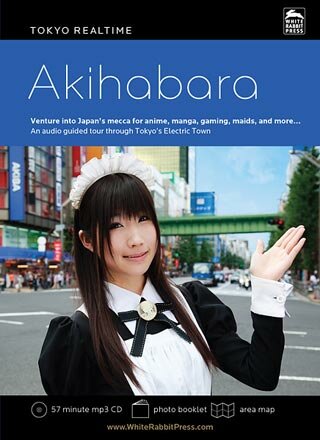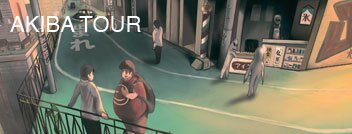.jpg) Filed under: Akihabara Development Otaku Otaku March Akihabara Massacre
Filed under: Akihabara Development Otaku Otaku March Akihabara MassacreAkihabara: A Year In Review
29.06.2008 by Patrick W. Galbraith
The saying goes that in Akihabara, Tokyo’s world famous “Electric Town” shopping district, one can find anything he or she desires. It is a place where dreams and fantasy are brought into reality for the local “otaku” fan cultures and the shoppers and tourists who come to share their world. But what the powers that be want most now is for the otaku to disappear.
"There are three periods in Akihabara, past, present and future,” said Kobayashi Takaya, a politician in Chiyoda Ward where Akihabara is located. “The past is the history, the present the current pop-culture boom, and the future the development of mega buildings and a contents industry. That future is coming as the otaku element quiets down.”
And he means to expedite that process with police force if necessary.
Kobayashi’s position is representative of the new wave of political posturing sweeping Akihabara since public interest was piqued by mass mediation and entrepreneurial appetites whetted for the annual $3.5 billion otaku industries centered in the area. Many fear an assertion of power at heavy cost to local cultures cultivated over half a century.
Akihabara is part of the shitamachi, or “lower city” in Tokyo, originally famous for its shrine of fire protection, Akiba Jinja. Japan Railways leveled the holy site when they built the train station in 1890, but “Akiba” lives on as an alternative name for the area. In the decades following WWII, Akiba became a black market for transistor radio parts pilfered from occupying GI forces (1940s) and then a market for appliances (50s and 60s), electronics (70s) and computers (80s).
By the 1980s, Akiba was already the largest electronics shopping mall in the world at 500 square meters, a futuristic hub for rare and innovative products.
But then otaku started showing up.
The media implicated such “deviant youth” groups in infamous crimes such as the Miyazaki serial killings of 1989. As other places became less welcoming of otaku in the 1990s, stores catering to them such as Kaiyodo in Shibuya moved to Akiba and sparked a mass immigration. Anime, manga and videogames became the currency of the land; the first high-rise building, the Radio Kaikan erected in 1955, was symbolically taken over by viral fandoms. Normal folk stayed away from the area as media reported the Aum Shinrikyo cult as “otaku” sociopaths in residence.
Fast forward 10 year and those same otaku who retarded Akiba’s growth were the ironic impetus to it.
“The popular perception of otaku changed in 2005 with Densha Otoko, The Train Man,” said Susan J. Napier, an expert on Japanese anime and pop-culture. “It was the first major television drama that had an otaku hero. The characters went to Akihabara and it seemed fun and bright, not evil and dark.”
Densha Otoko tells the supposedly true story of a lonely otaku who saves a woman being molested on the train. She falls for him, and a modern re-telling of beauty and the beast ensues wherein the socially inept man attempts to court the girl of his dreams. “Densha” seeks advice from his otaku friends, a pure hearted bunch who meet him online and in Akihabara to hear his story and encourage him.
One of their common meeting points, Akiba’s Pinafore - a “maid café” where staff wear the titular costume, welcome “masters” home and offer tabletop games as amusement - has since become a tourist magnet.
“Many people are looking for an amusement park, something like Disneyland,” said Eri, a Pinafore maid blithely chatting while writing a ketchup message on omelet rice. “It is really popular, so they come to check it out expecting to find something totally outrageous.”
The number of maid cafes in Akiba increased by nearly 2000 percent after Densha Otoko, and TV appearances by popular choices such as @home café increased by 685 percent between 2004 and 2005. Because Akiba has no filming restrictions, location costs are minimal and TV and film producers are treating the area as a discount alternative to Ginza, Shibuya or Roppongi.
Longing to reclaim the cachet of “Cool Japan,” Shibuya officials announced in 2007 they wanted to be more “like Akiba” and import maids.
The numbers illustrate the effect the “otaku boom” has had on Akiba: of all visitors, 10 percent come to buy electronics, 25 percent to buy computers, 30 percent to pursue otaku hobbies and 35 percent to site see (five percent from overseas).
It’s a linear progression from past to present, and tourists, not otaku, rule the roost.
Akihabara ranked among the top five places foreigners wanted to visit in Japan in 2007, cause for a fundamental shift in government policy. Rather than avoid otaku, Yokoso! Japan now offers weekly “Cool Akihabara” tours and the Japan National Tourist Organization actively markets the “Otaku Mecca.”
That most ubiquitous of normative icons, Hello Kitty, now adorns kitsch Akiba goods.
The culmination of this came when former Minister of Foreign Affairs Aso Taro came out as an “otaku” in Akiba in 2006. His highly publicized subsequent bids for the prime minister post were heavily salted with references to Japanese pop-cultural supremacy and harnessing the soft power of Japan’s contents industry to increase the nation’s influence the world over.
“We invented otaku and should take pride in that fact,” Aso said in a televised address. He pointed out that over 60 percent of animation shown in the world is Japanese and European soccer players idolize Captain Tsubasa, an anime icon.
On Aso’s watch countless legitimations of otaku diversions occurred, including the “Manga Noble Peace Prize,” Seiyuu (voice actors and actresses) Awards and Kyoto International Manga Museum. He is rumored to be working to establish special prizes for anime, cosplay (costume roleplay) and figures to usurp foreign critical authority.
Tokyo Mayor Ishihara Shintaro already has an International Anime Festival operating on similar assumptions.
With so much economic, social and political momentum for a globally appealing Akiba, leaders accelerated 1997 plans for redevelop the area into a contents industry showcase and “Silicon Valley” appealing beyond its otaku inhabitants. NTT Urban Development, Daibiru and Kajima Corporations received heavy subsidies to push the project to completion.
The iconic Daibiru tower sprung up on the north side of JR Akihabara Station in 2005, the same year the Tsukuba Express Line to Ibaraki Prefecture made northeast Akiba a commuting stop for middleclass suburban families. Japan’s largest Yodobashi Camera set up shop next door to effectively standardize discount prices on consumer appliances, electronics and computers.
The massive UDX Building and Crossfield were completed in 2006 north of the Daibiru tower behind the main otaku drag of Chuo-dori Street, and in 2007 the Fujisoft tower was erected midway between the Akiba-side and Tsukuba-side developments. The coup de grace connection marked the effective monopoly of the redevelopment trifecta in north and northeast Akihabara.

A headline in the Nikkei newspaper telegraphed the future as "otaku ceding domination of famous Electric Town as development lures IT firms," and slapdash construction has indeed spread into otaku territory in western Akiba.
The inflating land price shows the sharp effect of Akiba’s growth. The value of land near the Electric Town Exit of JR Akihabara Station increased 20.4 percent between 2006 and 2007. On the back streets near where the first maid café was founded in 2001, land prices have steadily risen by 10 percent a year over the past five years.
The closer a perspective buyer gets to what remains of the otaku zone on Chuo-dori Street and the redevelopment zone northeast of the station, the higher the prices become, according to a statement by a Bank of Japan official.
Despite talk of long-time residents being muscled out by cutthroat taxes and prices, Kobayashi and other figures take pride in the changes they in part orchestrated.
"There is already a salaryman culture here,” he said. “It is not as lively as other towns because yakuza and sexual services are limited to a small area on Showa-dori Street (east of the station), but the salaryman culture will expand. … Families, women with children, will come to Akihabara as the Tsukuba Express becomes more affordable.”
Around 5,000 people live in “Soto-Kanda,” or the Akihabara Electric Town. Many have already raised concerns about rowdy weekend gatherings when the streets are closed to vehicular traffic and otaku can freely “cross-play,” or costume as an anime character of the opposite sex, and perform “otagei,” the otaku art of singing and dancing before an idol singer. These concerns have only been exacerbated by the arrival of families touring Akiba or coming in on the Tsukuba Express.
“The things that are out of the ordinary for those who visit here to play are ordinary for the people who live here,” said Kobayashi, who also tracks commercial and otaku activity in his free magazine Akibatsu. “These are the people that file complaints, and we have to respond with police. If you are dancing or having a photo shoot in the street, people can't get by and are upset about that."
Now when Chuo-dori Street is closed to cars, the police patrol on foot to break up idol singer performances and photo shoots, otagei circles and cross-playing otaku dance routines.
Officials say otaku are loitering, littering and disturbing the peace. Forget their bringing in the tourists - that’s the past.
The heavy-handed response by law enforcement is in part born of conflating the issue of rising crime with complaints against otaku. Alarming media reports claim maid services are being taken over by gangs who flout the official limit on yakuza activity and enter Akiba proper to force girls into "compensated dating.” Shoplifters posing as otaku carrying the stereotypical daypack and prominent pirate software dealers from China are drawing scrutiny.
Confrontations between police and otaku have been increasingly heated, and Kobayashi among others have vowed to instill control and put a stop to it.
This came to a head when a mass otaku cooperative staged an unprecedented 500-fan march down the streets of Akiba in June 2007 after weeks of protest demonstrations.
“The police have been out harassing the cosplayers,” said Syuu-chan, the 28-year-old leader of Liberate Akihabara. “We want to make a paradise for otaku. Recently, that isn’t Akihabara.”
Mark Water, a 32-year-old alumnus of the prestigious graduate program at Akihabara’s Digital Hollywood University in the Daibiru, added, “We think a communist-style government fits Akiba best. This is a community, and we all have a right to contribute to it.”
The arrest of Sawamoto Asuka, 30, who violated the "prevention of nuisance" and "indecency" laws with public panchiras in April 2008, followed by a crack down on pellet gun and weapon-wielding otaku looking to avoid "otaku hunting" by thugs, only stiffened the atomosphere. Anti-otaku marches were the norm during the month of May.
Then, on June 8, Kato Tomohiro went on a random killing spree on Chuo-dori, taking seven lives and crushing the playful atomsphere of the anime Mecca.
By mid-June, the Walker's Paradise was closed down, the future of otaku was uncertain and Akihabara was in flux.
"Akihabara is changing so quickly, someone needs to record its history," said Yanagihara Hideya, editor of Akiba Keizai Shimbun. Yanagihara’s book on "cool otaku" and global Akiba sold 10,000 copies in three months.
As a result of such reporting, some postive changes do seem possible.
"There is a new law in the works for Akihabara that will limit the height of new buildings,” explained Kobayashi. “However, that law cannot go into effect until 2009, so rapid growth will increase in 2008 as contractors rush to get buildings up."
Will the otaku persevere that long? Specialist Patrick Macias has suggested they will instead emigrate to other, less visible corners of Tokyo where society won’t bother them. He summed up an article in the Japan Times by saying “the true face of otaku culture is hardly ready for prime time.”
Experts say that for the very sake of the neighborhood’s vitality policy makers must reconsider the contradictory course of developing a playground of “Cool Japan” that runs off the otaku that enlivened Akiba and brought the global and media interest in the first place.
“You have figures being sold in a store right next to high-tech parts, and that coexistence of the industrial and creative is one of the special characteristics of Akihabara,” said Nakamura Ichiya of Keio University’s Research Institute for Digital Media and Content. “It is precisely because that hard element is complemented by the creative hobby element that incredible developments occur here.”
Comment on this article

01.07.2010 · Features
Momoi Halko: The voice of moe is surprisingly deep!
Interview excerpts and random thoughts
07.06.2010 · Blog
Sucked into the Black Hole AKA 4chan
We just received an "Anonymous" email informing us of Patrick's debut over at 4chan's Otaku Encyclopedia thread. Guess I'll have to sift...
30.05.2010 · Blog
The Politics of Popular Culture
Temple University Japan will be holding two conferences on Japanese popular culture as part of the maid cafes. Each event is 1,000 yen,...
17.05.2010 · Blog
Nippombashi in Akihabara
Just walking on a side street in Akiba and looked up to see a giant billboard featuring Neon-chan from ita laptop I have been lusting after...
28.04.2010 · Blog
Evil behind the Akiba Smile!
This advertisement is rich, given the "Evangelion" - "God's in his Heaven. All's right with the world!" Who are they trying to convince? We...
24.04.2010 · Blog
Akihabara Gundam Cafe & Bar Opens Tomorrow!
Look out Starbucks the grand opening of the Akihabara Gundam Cafe and Bar starts tomorrow at 8:30am. I've lived here long enough to never...

31.03.2010 · Blog
On the prowl for banned goods
I visited an underground collector in Koenji who had literally rooms full of books, CDs and items that had been banned in Japan. He also...
Read on... 0 Comments
25.03.2010 · Blog
Sexy legs, no faces
Just walking through Akihabara and saw this sign for an independently produced erotic video. It is of the sentai-hentai variety, or mixing...
























